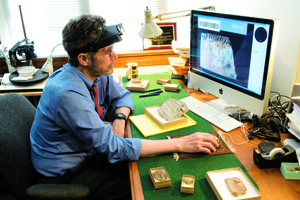Persia’s life story, online
By Lydialyle Gibson
Photography by Lloyd DeGrane
 Under Darius I, the Achaemenid dynasty ruler known as Darius the Great, ancient Persia expanded dramatically, reaching from the Indus Valley and Central Asia to Egypt and the Mediterranean Sea. Arts and culture flourished; huge building projects yielded palace cities at Persepolis and Susa.
Under Darius I, the Achaemenid dynasty ruler known as Darius the Great, ancient Persia expanded dramatically, reaching from the Indus Valley and Central Asia to Egypt and the Mediterranean Sea. Arts and culture flourished; huge building projects yielded palace cities at Persepolis and Susa.
But Darius was a bureaucrat as much as a conqueror. Ruling from 522 to 486 BC, he brought administrative order to the sprawling empire. That story unfolds in thousands of cuneiform tablets. Excavated from Persepolis, the ancient capital, and on loan to the Oriental Institute from Iran since 1936 as part of the Persepolis Fortification Archive, they record the storage and distribution of food, wine, and grain. From a broader perspective, they offer a glimpse at ancient Iranian society from the humblest worker to the royal family.
Now OI researchers, including Assyriologist Matthew Stolper, above, are digitizing the tablets using technology that allows scholars around the world to view them as if turning them over in their own hands. Since 2004 the tablets have been the focus of a lawsuit seeking to seize them as compensation for victims of a Hamas suicide bombing, heightening the urgency of OI scholars’ research.
The digitization work began in 2007 with support from the Mellon Foundation, and it entered a new phase in April with a second, $700,000 Mellon grant. By 2010 the researchers hope to have 10,000 of the archive’s 30,000 tablets digitized (many others were already returned, unrecorded, to Iran). Stolper leads the team, which includes collaborators from several universities. “It is no exaggeration,” he says, “to say this knowledge has transformed every aspect of the study of the languages, history and society, institutions and art of the Achaemenid Empire.”
WRITE THE EDITOR
E-MAIL THIS ARTICLE
SHARE THIS ARTICLE
RELATED READING
- "Worth millions...or priceless?" (University of Chicago Magazine, Oct/06)
- "Take one tablet..." (University of Chicago Magazine, Nov–Dec/07)
